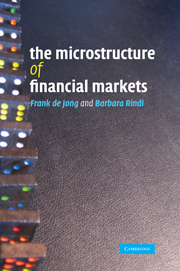Book contents
- Frontmatter
- Contents
- List of figures
- List of tables
- Preface
- Introduction
- 1 Institutions and market structure
- 2 Financial market equilibrium
- 3 Batch markets with strategic informed traders
- 4 Dealer markets: information-based models
- 5 Inventory models
- 6 Empirical models of market microstructure
- 7 Liquidity and asset pricing
- 8 Models of the limit order book
- 9 Price discovery
- 10 Policy issues in financial market structure
- Index
1 - Institutions and market structure
Published online by Cambridge University Press: 05 June 2012
- Frontmatter
- Contents
- List of figures
- List of tables
- Preface
- Introduction
- 1 Institutions and market structure
- 2 Financial market equilibrium
- 3 Batch markets with strategic informed traders
- 4 Dealer markets: information-based models
- 5 Inventory models
- 6 Empirical models of market microstructure
- 7 Liquidity and asset pricing
- 8 Models of the limit order book
- 9 Price discovery
- 10 Policy issues in financial market structure
- Index
Summary
This chapter sets out the basics of institutions and market organization, concentrating on those elements which are most useful in discussing the theory. The book by Harris (2003) provides an excellent reference manual and where further clarification is required or if more in-depth examination is desired, we refer the student to that text.
Trading protocol
The organizational structure of a financial market comprises the rules that regulate trading and the trading procedures. The market structure indicates who can access the trading venue, which instruments can be traded, the location of the trading sessions and the order routing systems. The market structure also spells out the rules governing the access of market participants to public and private information and so affects the degree of pre- and post-trade transparency decisively. It follows that the market structure has an impact on agents' trading strategies and therefore on market quality.
This chapter discusses how different market structures can be classified, according to both the order execution systems and to the type of trading sessions. As far as execution systems are concerned, markets can be classified as either order-driven or quote-driven. Markets based on the direct interaction of agents' orders are commonly called order-driven, whilst those where contracts must be fulfilled through intermediaries are called quote-driven; markets where both systems are in use are called hybrid. As will be discussed later in this chapter, most financial markets today have a hybrid protocol, as it is quite flexible in accommodating the liquidity needs of different instruments.
- Type
- Chapter
- Information
- The Microstructure of Financial Markets , pp. 7 - 31Publisher: Cambridge University PressPrint publication year: 2009



